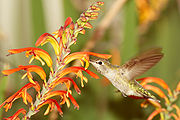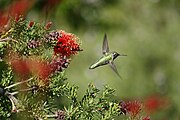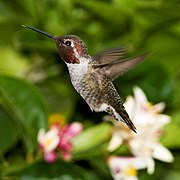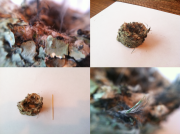We usually call them "Ruby throated" hummingbirds here in California. (at least that's the name I have always heard before. I have seen them in San Diego, Los Angeles, but also on the northern California coast. I was watching one nesting in a pine tree and wondered if that was their favorite tree locally. I was sitting in my hot tub and noticed one was tending a nest in this pine tree and wondered about it. my wife makes hummingbird food with water and some kind of sugar mix I believe that is similar to flower nectar and has two feeders here and more in Santa Barbara too. They hang on chains from our roof eves in on our deck in our back yard.
begin quote from:
Anna's hummingbird
| Anna's hummingbird | |
|---|---|
 | |
| Male flying in California, USA | |
 | |
| Female hovering | |
| Scientific classification | |
| Kingdom: | Animalia |
| Phylum: | Chordata |
| Class: | Aves |
| Order: | Apodiformes |
| Family: | Trochilidae |
| Genus: | Calypte |
| Species: |
C. anna
|
| Binomial name | |
| Calypte anna
(Lesson, 1829)
| |
 | |
| Range of C. anna Wintering range Breeding and wintering range | |
Anna's hummingbird (Calypte anna), a medium-sized hummingbird native to the west coast of North America, was named after Anna Masséna, Duchess of Rivoli.[2] In the early 20th century, Anna's hummingbirds bred only in northern Baja California and southern California. The transplanting of exotic ornamental plants in residential areas throughout the Pacific coast and inland deserts provided expanded nectar and nesting sites, allowing the species to expand its breeding range.[2][3]
Description[edit]
Anna's hummingbird is 3.9 to 4.3 in (9.9 to 10.9 cm) long. It has an iridescent bronze-green back, a pale grey chest and belly, and green flanks. Its bill is long, straight, and slender. The adult male has an iridescent crimson-red derived from magenta to a reddish-pink crown and gorget, which can look dull brown or gray without direct sunlight and a dark, slightly forked tail. Females also have iridescent red gorgets, though they are usually smaller and less brilliant than the males'. Anna's is the only North American hummingbird species with a red crown.[3] Females and juvenile males have a dull green crown, a grey throat with or without some red iridescence, a grey chest and belly, and a dark, rounded tail with white tips on the outer feathers.
These birds feed on nectar from flowers using a long extendable tongue. They also consume small insects and other arthropods caught in flight or gleaned from vegetation. A PBS documentary shows how Anna's hummingbirds eat flying insects.[4] They aim for the flying insect, then open their beaks to capture the prey.
While collecting nectar, they also assist in plant pollination. This species sometimes consumes tree sap.[5] The male's call is scratchy and metallic, and it perches above head-level in trees and shrubs.[3] They are frequently seen in backyards and parks, and commonly found at feeders and flowering plants.
Anna's hummingbirds can shake their bodies 55 times per second to shed rain while in flight, or in dry weather, to remove pollen or dirt from feathers.[6] Each twist lasts four-hundredths of a second and applies 34 times the force of gravity on the bird's head.
Reproduction[edit]
Open-wooded or shrubby areas and mountain meadows along the Pacific coast from British Columbia to Arizona make up C. anna's breeding habitat. The female raises the young without the assistance of the male. The female bird builds a nest in a shrub or tree, in vines, or attached to wires or other artificial substrates. The round, 3.8-to-5.1-centimetre (1.5 to 2.0 in) diameter nest is constructed of plant fibers, downy feathers and animal hair; the exterior is camouflaged with chips of lichen, plant debris, and occasionally urban detritus such as paint chips and cigarette paper.[2] The nest materials are bound together with spider silk. They are known to nest as early as mid-December and as late as June, depending on geographic location and climatic conditions[7] [8].
Unlike most northern temperate hummingbirds, the male Anna's hummingbird sings during courtship. The song is thin and squeaky, interspersed with buzzes and chirps, and is drawn to over 10 seconds in duration. During the breeding season, males can be observed performing an aerial display dive over their territories. The males also use the dive display to drive away rivals or intruders of other species. When a female flies onto a male's territory, he rises up about 130 ft (40 m) before diving over the recipient. As he approaches the bottom of the dive, the male reaches an average speed of 27 m/s (89 ft/s), which is 385 body lengths per second.[9] At the bottom of the dive, the male travels 23 m/s (51 mph), and produces a loud sound described by some as an "explosive squeak" with his outer tail-feathers.[10][11]
Anna's hummingbirds hybridize fairly frequently with other species, especially the congeneric Costa's hummingbird.[2] These natural hybrids have been mistaken for new species. A bird, allegedly collected in Bolaños, Mexico, was described and named Selasphorus floresii (Gould, 1861), or Floresi's hummingbird. Several more specimens were collected in California over a long period, and the species was considered extremely rare.[12] The specimens were the hybrid offspring of an Anna's hummingbird and an Allen's hummingbird. A single bird collected in Santa Barbara, California, was described and named Trochilus violajugulum (Jeffries, 1888), or violet-throated hummingbird.[13] It was later determined to be a hybrid between an Anna's hummingbird and a black-chinned hummingbird.[14][15]
Locomotion[edit]
During hovering flight, Anna's hummingbirds maintain high wingbeat frequencies accomplished by their large pectoral muscles via recruitment of motor units.[16] The pectoral muscles that power hummingbird flight are composed exclusively of fast glycolytic fibers that respond rapidly and are fatigue-resistant.[16]
Distribution[edit]
Anna's hummingbirds are found along the western coast of North America, from southern Canada to northern Baja California, and inland to southern and central Arizona, extreme southern Nevada and southeastern Utah, and western Texas.[2] They tend to be permanent residents within their range, and are very territorial. However, birds have been spotted far outside their range in such places as southern Alaska, Saskatchewan, New York, Florida, Louisiana, and Newfoundland.[17][18]
While the species was originally restricted to the chaparral of California and Baja California, their range expanded north to Oregon, Washington, and British Columbia, and east to Arizona in the 1960s and 70s. This rapid expansion can be attributed to the widespread planting of non-native species, such as eucalyptus, as well as the use of bird feeders, in combination with the species' natural tendency for extensive postbreeding dispersal.[7][19]
Anna's hummingbirds have the northernmost year-round range of any hummingbird. During cold temperatures, Anna's hummingbirds gradually gain weight during the day as they convert sugar to fat.[20][21] In addition, hummingbirds with inadequate stores of body fat or insufficient plumage are able to survive periods of subfreezing weather by lowering their metabolic rate and entering a state of torpor.[22]
The population of Anna's hummingbirds is an estimated 1.5 million, which appears to be stable, and they are not considered an endangered species.[1] In 2017, Anna's hummingbird was named the official bird of the city of Vancouver, British Columbia, Canada,[23] where it resides year round through winter.[24]












No comments:
Post a Comment